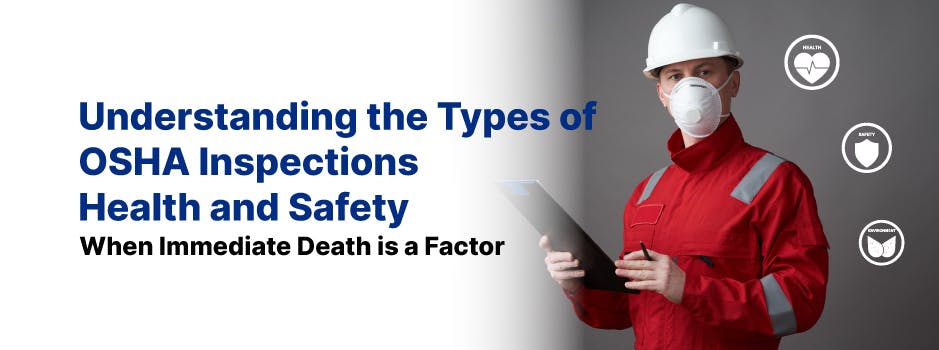Occupational Safety and Health Administration (OSHA) inspections are crucial for ensuring the safety of employees in the workplace. They play a vital role in identifying hazards, enforcing regulations, and protecting workers from harm. In this blog post, we will discuss the different types of OSHA inspections, with a particular focus on those conducted in response to situations involving immediate death or severe injury. By understanding the various types of inspections, employers can better prepare for and comply with OSHA's regulations, creating a safer work environment for all.
The Importance of OSHA Inspections
OSHA inspections are essential to maintaining a safe and healthy work environment. They not only help identify potential hazards and ensure compliance with safety regulations, but they also encourage employers to implement best practices in the workplace. When a company is aware of the risks and consequences associated with non-compliance, they are more likely to prioritize worker safety and make the necessary changes to protect its employees.
Types of OSHA Inspections
OSHA conducts several types of inspections, each with its specific purpose and focus. They can be categorized as follows:
- Imminent Danger Inspections: These inspections are conducted when OSHA receives a report of an imminent danger, which could result in death or severe injury if not addressed immediately. In these cases, OSHA prioritizes the inspection to prevent further harm to workers. Imminent danger inspections are the focus of this blog post.
- Fatality and Severe Injury Inspections: When a workplace incident results in a fatality or hospitalization, amputation, or loss of an eye, employers are required to report the incident to OSHA within specific timeframes. OSHA will then conduct an inspection to determine the cause of the incident and take appropriate action.
- Complaint and Referral Inspections: OSHA investigates complaints from employees, their representatives, or referrals from other agencies regarding hazards in the workplace. These inspections may be unannounced and focus on the specific issue reported.
- Programmed Inspections: OSHA conducts programmed inspections based on specific industries or workplaces with a high rate of injuries and illnesses. These inspections target workplaces that may present significant hazards to workers.
- Follow-up Inspections: After a company has been cited for violations, OSHA may conduct a follow-up inspection to ensure that the employer has corrected the issues and is in compliance with regulations.
Imminent Danger Inspections: When Immediate Death is a Factor
Imminent danger inspections are initiated when OSHA receives a report of a situation that threatens workers' lives or safety. This type of inspection is given the highest priority, as the goal is to address the hazard as quickly as possible to prevent further harm.
To warrant an imminent danger inspection, the reported hazard must meet specific criteria, including:
- The danger must be imminent, meaning it will likely cause death or severe injury if not addressed immediately.
- Based on the information provided, there must be a reasonable expectation that the hazardous condition exists.
- The danger must be specific and not a general concern about workplace safety.
Upon receiving a report of an imminent danger, OSHA will dispatch a Compliance Safety and Health Officer (CSHO) to the worksite to assess the situation. If the CSHO confirms the presence of an imminent danger, they will inform the employer of the hazard and request immediate corrective action. If necessary, the CSHO may also order the employer to remove workers from the area until the hazard is resolved.
Employer Responsibilities in Imminent Danger Situations
In cases of imminent danger, employers have a responsibility to act quickly to protect their employees. Employers should:
- Immediately address the hazard and take corrective action to ensure the safety of all workers.
- Cooperate with OSHA during the inspection process, providing necessary documentation and access to the worksite.
- Inform employees of the imminent danger situation and any actions taken to address it.
- Train workers on proper safety procedures and provide necessary personal protective equipment (PPE) to minimize the risk of injury.
- Implement a robust safety program to prevent similar hazards from occurring in the future.
How Employers Can Prepare for Imminent Danger Inspections
Although imminent danger inspections are unexpected, employers can take steps to prepare for these situations and ensure a smooth inspection process. Some best practices include:
- Developing and maintaining a comprehensive safety program that includes hazard assessments, regular inspections, and employee training.
- Designating a safety coordinator or team responsible for overseeing workplace safety and OSHA compliance.
- Encouraging employees to report any hazards or concerns promptly and taking those reports seriously.
- Regularly reviewing and updating safety policies and procedures to keep up with industry standards and OSHA regulations.
- Conducting mock OSHA inspections to identify and address potential hazards before they escalate into imminent danger situations.
Conclusion
OSHA inspections are an integral part of ensuring worker safety and promoting compliance with regulations. Imminent danger inspections, in particular, are critical for addressing hazards that pose an immediate threat to workers' lives or health. By understanding the types of OSHA inspections and taking proactive measures to maintain a safe work environment, employers can better protect their employees and avoid the negative consequences of non-compliance.
Remember that a safe workplace benefits everyone – employees, employers, and the community as a whole. So, invest in creating and maintaining a safe work environment, and encourage a culture of safety that prioritizes the well-being of all workers.

